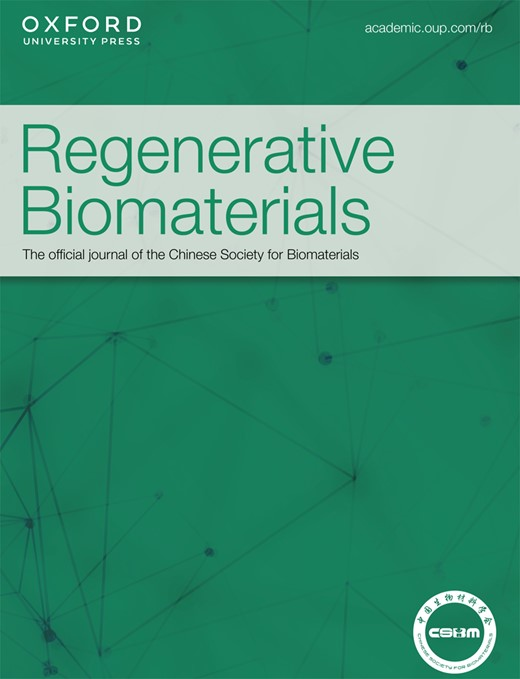用于原位中空细胞球自组装的液态核心-凝胶马(GelMa)外壳微珠的一步生物制造技术
IF 5.6
1区 医学
Q1 MATERIALS SCIENCE, BIOMATERIALS
引用次数: 0
摘要
在组织发育过程中,有许多空心结构形态发生的实例。因此,利用适当的天然生物材料组合,以简单、高通量、均质的方式制造中空结构,对于发育研究和组织工程具有重要价值,同时也是生物制造领域的一项重大挑战。我们提出了一种利用同轴共流毛细管微流体装置制造中空细胞模块的新方法。通过同轴共流毛细管微流体装置,在内层使用载满细胞的人工明胶,在外层使用 GelMa,制备出均匀的微珠。核壳微珠的整体尺寸和核心尺寸都得到了很好的控制。在使用人静脉血管内皮细胞(HUVECs)演示细胞如何排列在核壳微珠的内表面时,随着核的液化,一个具有不对称特征的空心细胞球被制造出来。从 GelMa 外壳释放后,可获得单个细胞球,变形的细胞球可以自我恢复。该平台为体外复杂的中空组织建模铺平了道路,并可进一步调节基质硬度、曲率和生化成分,以模拟体内微环境。本文章由计算机程序翻译,如有差异,请以英文原文为准。
One-step biofabrication of liquid core—GelMa shell microbeads for in situ hollow cell ball self-assembly
There are many instances of hollow-structure morphogenesis in the development of tissues. Thus, the fabrication of hollow structures in a simple, high-throughput, and homogeneous manner with proper natural biomaterial combination is valuable for developmental studies and tissue engineering, while it is a significant challenge in biofabrication field. We present a novel method for the fabrication of a hollow cell module using a coaxial co-flow capillary microfluidic device. Sacrificial gelatin laden with cells in the inner layer and GelMa in the outer layer are used via a coaxial co-flow capillary microfluidic device to produce homogenous micro-beads. The overall and core sizes of core-shell microbeads were well controlled. When using human vein vascular endothelial cells (HUVECs) to demonstrate how cells line the inner surface of core shell beads, as the core liquifies, a hollow cell ball with asymmetric features is fabricated. After release from the GelMa shell, individual cell balls are obtained and deformed cell balls can self-recover. This platform paves way for complex hollow tissue modelling in vitro, and further modulation of matrix stiffness, curvature, and biochemical composition to mimic in vivo microenvironments.
求助全文
通过发布文献求助,成功后即可免费获取论文全文。
去求助
来源期刊

Regenerative Biomaterials
Materials Science-Biomaterials
CiteScore
7.90
自引率
16.40%
发文量
92
审稿时长
10 weeks
期刊介绍:
Regenerative Biomaterials is an international, interdisciplinary, peer-reviewed journal publishing the latest advances in biomaterials and regenerative medicine. The journal provides a forum for the publication of original research papers, reviews, clinical case reports, and commentaries on the topics relevant to the development of advanced regenerative biomaterials concerning novel regenerative technologies and therapeutic approaches for the regeneration and repair of damaged tissues and organs. The interactions of biomaterials with cells and tissue, especially with stem cells, will be of particular focus.
 求助内容:
求助内容: 应助结果提醒方式:
应助结果提醒方式:


